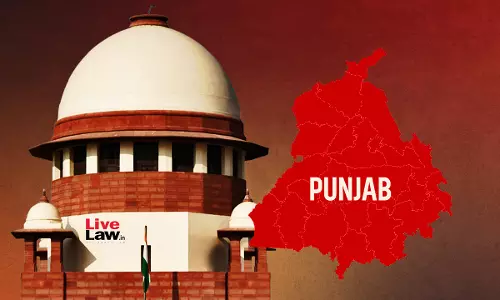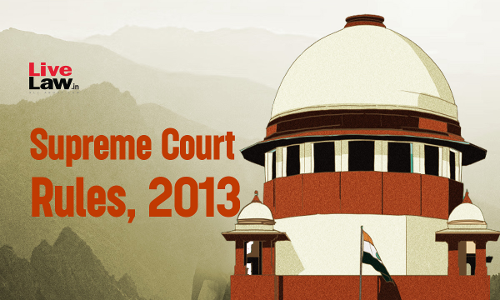Whether MMDR Act Excludes State's Power To Tax Mineral Rights? Supreme Court 9-Judge Bench Hears Arguments [Day 7]
![Whether MMDR Act Excludes States Power To Tax Mineral Rights? Supreme Court 9-Judge Bench Hears Arguments [Day 7] Whether MMDR Act Excludes States Power To Tax Mineral Rights? Supreme Court 9-Judge Bench Hears Arguments [Day 7]](https://www.livelaw.in/h-upload/2024/03/14/1500x900_528109-9-judge-constitution-bench.webp)
On the 7th day of its hearing, the Supreme Court 9 Judge Constitution Bench dwelled into the interplay between the nature of limitations imposed under Entry 50 List II (State's Powers on taxes on mineral rights); Powers of the Union over regulation and development of mines and minerals and the residuary powers given to the Union under Entry 97 List I. Senior Advocate Dr AM Singhvi urged the...
On the 7th day of its hearing, the Supreme Court 9 Judge Constitution Bench dwelled into the interplay between the nature of limitations imposed under Entry 50 List II (State's Powers on taxes on mineral rights); Powers of the Union over regulation and development of mines and minerals and the residuary powers given to the Union under Entry 97 List I. Senior Advocate Dr AM Singhvi urged the bench to examine the distinction between taxes on minerals on one hand and the concept of taxing 'mineral rights' on the other.
Dr AM Singhvi in the heart of his submission, argued that Entry 50 List II functions as a look-back provision, emphasizing its focus on taxing powers and its dependence on limitations set by Entry 54 List I. He contended that once Entry 50 List II references Entry 54 List I and levies taxes, Entry 97 List I cannot be disregarded.
Entry 50 List II relates to State's power on taxes on mineral rights subject to any limitations imposed by Parliament by law relating to mineral development. Entry 54 List I deals with Union's Power over Regulation of Mines and Mineral Development. Entry 97 List I refers to any matter not mentioned in Lists II & III including any tax not mentioned in either of those lists.
He further dissected the provision of Entry 50 List II. It was stressed that (1) the provision was on taxing power; (2) it looks back to the limitations on interalia qua taxes by a superior provision, that is Entry 54 List I; (3) once it looks back to Entry 54ListI and taxes the subject matter, then Entry 97 List I cannot be ignored.
" You have to read Entry 54 List I synergistically. I am not reading Entry 97 List I as stand alone. 97 has no value stand alone. But once Entry 50 List II is looking back on Entry 54 List I, 54 and 97 (Entries) must be read synergistically.”
However, the CJI noted a fallacy in this argument, highlighting that even with limitations of Entry 54 List I, taxes mentioned in Entry 50 List II remain valid. The CJI further explained that Entry 97 List I was intended to encompass future taxes unforeseen by the Constitution's framers. for instance the service tax or the GST.
"Even if there is a limitation imposed under Entry 54 List I that tax doesn't cease to be a tax mentioned in any of the Lists. The tax still continues to be mentioned in one of the lists (in Entry 50 List II) …. according to you, states cannot tax royalties at all because of the MMDR limitation. Suppose Parliament imposes a limitation short of an absolute limitation…in which case it can well be argued that Parliament retained the power to tax minerals rights bereft of the limitation that it imposes on the states. That can never be.”
Responding to this, Mr. Singhvi contended that if Parliament exercises power over mineral development, which constitutes a limitation under Entry 50 List II, the accompanying taxing powers align with Entry 97 List I.
"If parliament makes power on mineral development which is a limitation (on Entry 50 List II) the taxing powers go concomitantly with Entry 97 List I"
It was further contended by Dr Singhvi that Sections 9 (royalties in respect of mining leases), 9A (dead rent paid by lessee), 9B (On District Mineral Foundation) of the MMDR Act, 1957 provide for taxes because they are compulsory imposts by a public authority enforceable by coercive measures (land revenue etc) and are changeable only by statutory amendment. The Provision under S.9C( On National Mineral Exploration Trust) of the Act is however a fee because there is an expression of quid-pro-qua of exploration.
Clarity Sought on Taxation Distinction: Minerals vs. Mineral Rights
In a crucial legal argument, Dr. Singhvi called for the court's elucidation on differentiating between taxes on minerals and taxes on mineral rights. He emphasized the stark contrast, explaining that taxing minerals involves extraction from the earth, while taxing mineral rights pertains to leases and licenses based on duration and size, not actual extraction.
Weighing in, Justice Nagarathna observed that royalties are on the removed and consumed mineral product, refuting any dichotomy with taxes on mineral rights under Entry 50 List II.
“But the royalty is on the mineral removed or consumed, it is on the product. But a tax on mineral right is under Entry 50 List II….so the royalty is not on mineral rights, but the mineral removed and consumed, so there is no dichotomy at all.”
Agreeing to the same Dr Singhvi expressed, “Thats all I am asking for, thats my submission.”
Another short submission that was made was that once Entry 23 List II (State's powers on regulations on mines and mineral developments) is denuded, then Entry 66 List II qua the fees cannot lie as it is a piggyback provision which lies in Entry 23 List II. Entry 66 List I empowers states to levy taxes on the capital value of assets, excluding agricultural land, belonging to individuals and companies, as well as taxes on the capital of companies.
“Entry 66 List II gets pro tanto gets eclipsed or inapplicable.”
Highlighting from his written submissions, Mr Singhvi asserted the decision in State of West Bengal v. Kesoram Industries Ltd. to be "grievously wrong”. Mr Singhvi pointed out the Kesoram being a 5-judge bench could not have overruled a 7-judge bench decision in India Cement Ltd. v. State of T.N., (1990) 1 SCC 12
Sr Advocate AK Ganguly made the following points in his brief submissions : (1) the law made by the Parilament under Entry 54 List I subsumes the entire content of Entry 23 List II- however the CJI objected to the same pointing that doing so would be glossing over the words, “To the extent to which”. Mr Ganguly relied upon the term “limitation' under Entry 50 List II explaining that such limitation would allow the Parliament to subsume the powers under Entry 23 List II; (2) the tax under Entry 50 is on mineral rights and not minerals; (3) MMDR Act is the limitation enacted by the Parliament to restrain the powers of the states to tax on mineral rights (for example MMDR also provides for taxing dead rent which becomes part of mineral rights)
While Mr Ganguly also attempted to raise a contention on examining the scope and impact of the MMDR Act, CJI intervened to suggest that such an aspect could be dealt separately by a regular bench and need not be examined in the present questions put forth for reference before the 9 Judge Bench.
In the second half of the hearing, several intervenors made their brief submissions.
Senior Advocate Mr SK Bagaria glossed over the elemental break down of the wordings of Entry 50 List II and noted that such an entry on tax was inique as the limitation is provided for was not present in any other similar entry relating to taxes. The limitation under Entry 50 List II , argued Mr Bagaria was self-imposed by the Entry.
Senior Counsel Mr Darius Khambata broke down his argument into 5 main points : (1) The states do not have exclusive competence to even tax mineral rights, it is always subject to the parliament ; (2) The Limitation under Entry 50 List II includes the Powers of the Parliament under Entries 54, 97 of List I along with Article 248; (3) limitation under Entry 50 List II can be related to the field of taxation; (4) Entry 54 List I envisaged a complete code on the law relating to Mineral development and this includes the aspect of taxation; (5) Under the Constitutional scheme, limitations include implied limitations as well and not just express limitations, such implications can be either by necessity or from the scheme of the constitution.
Other advocates including Sr Advocate Mr Arvind Datar, and ASG Aishwarya Bhati submitted on similar lines to the arguments made on behalf of the Union, highlighting that taxing power must yield to parliamentary legislation and that the division of powers tilting towards Union on issues of mineral development is done for the sake of maintaining inter-generational equity of resources for the country.
The court concluded the main submissions on both sides today. The bench clarified that tomorrow the rejoinder arguments would be heard briefly.
Background
The key reference question involved in the present matter is to examine the nature and scope of royalty as prescribed under Section 9 of the Mines and Minerals (Development and Regulation) Act, 1957 (MMDR Act) and whether it could be termed as tax.
The matter was referred to 9 judge bench in 2011. A three-judge bench headed by Justice SH Kapadia had framed eleven questions to be referred to the nine-judge bench. These include important tax law questions such as whether 'royalty' can be considered as being like tax and can the State Legislature while levying a tax on land adopts a measure of tax based on the value of the produce of land. The three-judge bench clarified in this case that the reason why it was not referred to a five-judge bench and directly referred to a nine-judge bench was because prima facie, there appeared to be some conflict in the decisions of State of West Bengal v. Kesoram Industries Ltd. and Ors which was delivered by a bench of five-Judges and India Cement Ltd. and Ors. v. State of Tamil Nadu and Ors. which were delivered by seven-judge benches.
Case details : Mineral Area Development v. M/S Steel Authority Of India & Ors (CA N0. 4056/1999)


![Last Date to Get 30% Discount On LiveLaw Academys Judicial Service Examination Preparation Courses [Apply Now!] Last Date to Get 30% Discount On LiveLaw Academys Judicial Service Examination Preparation Courses [Apply Now!]](https://www.livelaw.in/h-upload/2025/04/12/500x300_595581-lla-early-bird-750-x-450.webp)

